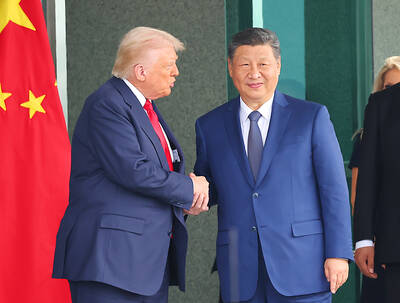US President Donald Trump on Tuesday called for ending a bipartisan US$52 billion semiconductor subsidy program — the CHIPS and Science Act — that has spurred more than US$400 billion in investments from companies like Taiwan Semiconductor Manufacturing Co (TSMC, 台積電) and Intel Corp.
“Your CHIPS Act is horrible, horrible thing,” the US president said in a prime-time address to Congress.
Trump implored US House of Representatives Speaker Mike Johnson to get rid of the legislation and use “whatever is left over” of funds apportioned to the program to “reduce debt or any other reason.”

Photo: Bloomberg
His remarks were met with applause in a chamber that less than three years ago passed the CHIPS and Science Act. US Vice President JD Vance, whose home state of Ohio won a massive Intel project thanks to the law, stood up to show his support for its revocation.
The CHIPS Act is among the most significant US forays into industrial policy in more than a generation. It set aside US$39 billion in grants — plus loans and 25 percent tax breaks — to revitalize US semiconductor manufacturing, as well as US$11 billion for chip research and development.
Democrats and Republicans have touted the CHIPS Act as crucial to US national and economic security, and Trump could have a hard time getting the votes to repeal it. Dozens of Republican lawmakers voted for the measure, and many red districts have won factories or other projects supported by the law.
TSMC and South Korea’s Samsung Electronics Co and SK Hynix Inc have announced or begun construction on multibillion-dollar projects in the US that were contingent on funding and support from the US government.
Representatives of the companies declined to comment on the president’s remarks.
What that actually means for TSMC is murky. The company originally announced plans for a US$12 billion US site during Trump’s first term and expanded that project to three factories under former US president Joe Biden. To support those facilities, TSMC struck an agreement with Biden officials for US$6.6 billion in CHIPS Act grants and US$5 billion in loans.
As is the case for other CHIPS Act awards, the funding is supposed to be disbursed over time, as TSMC hits negotiated project milestones. The company received US$1.5 billion before Biden left office.
However, the company’s newly announced projects — three additional chip plants, plus a research and development center and a factory for advanced packaging — will not win federal funds, US Secretary of Commerce Howard Lutnick said on Monday.
“The main uncertainty is the future of TSMC,” abrdn PLC investment director Xin-Yao Ng (黃新耀) said. “One long-time competitive advantage was their clustering in Taiwan, where labor costs are still reasonable, construction costs are cheaper, government is supportive and they can find more workers with vocational training. It is completely different in the US if they are to shift more manufacturing. Subsidies from US were to be crucial to help mitigate some of the higher costs and challenges.”
TSMC is among 20 companies, which include Micron Technology Inc, GlobalFoundries Inc and Texas Instruments Inc, that reached binding CHIPS Act agreements with Biden officials.
Companies have generally viewed those agreements as ironclad — regardless of who is in office.
However, some of them are worried that the Trump administration could seek to modify the terms. Lutnick has said he cannot commit to honoring existing contracts without reviewing them first.
Meanwhile, the current CHIPS Act team has been preparing a list of potential adjustments to the funding application process and final contracts that would be minimally disruptive.

TEMPORARY TRUCE: China has made concessions to ease rare earth trade controls, among others, while Washington holds fire on a 100% tariff on all Chinese goods China is effectively suspending implementation of additional export controls on rare earth metals and terminating investigations targeting US companies in the semiconductor supply chain, the White House announced. The White House on Saturday issued a fact sheet outlining some details of the trade pact agreed to earlier in the week by US President Donald Trump and Chinese President Xi Jinping (習近平) that aimed to ease tensions between the world’s two largest economies. Under the deal, China is to issue general licenses valid for exports of rare earths, gallium, germanium, antimony and graphite “for the benefit of US end users and their suppliers

Nissan Motor Co has agreed to sell its global headquarters in Yokohama for ¥97 billion (US$630 million) to a group sponsored by Taiwanese autoparts maker Minth Group (敏實集團), as the struggling automaker seeks to shore up its financial position. The acquisition is led by a special purchase company managed by KJR Management Ltd, a Japanese real-estate unit of private equity giant KKR & Co, people familiar with the matter said. KJR said it would act as asset manager together with Mizuho Real Estate Management Co. Nissan is undergoing a broad cost-cutting campaign by eliminating jobs and shuttering plants as it grapples

Dutch chipmaker Nexperia BV’s China unit yesterday said that it had established sufficient inventories of finished goods and works-in-progress, and that its supply chain remained secure and stable after its parent halted wafer supplies. The Dutch company suspended supplies of wafers to its Chinese assembly plant a week ago, calling it “a direct consequence of the local management’s recent failure to comply with the agreed contractual payment terms,” Reuters reported on Friday last week. Its China unit called Nexperia’s suspension “unilateral” and “extremely irresponsible,” adding that the Dutch parent’s claim about contractual payment was “misleading and highly deceptive,” according to a statement

The Chinese government has issued guidance requiring new data center projects that have received any state funds to only use domestically made artificial intelligence (AI) chips, two sources familiar with the matter told Reuters. In recent weeks, Chinese regulatory authorities have ordered such data centers that are less than 30 percent complete to remove all installed foreign chips, or cancel plans to purchase them, while projects in a more advanced stage would be decided on a case-by-case basis, the sources said. The move could represent one of China’s most aggressive steps yet to eliminate foreign technology from its critical infrastructure amid a